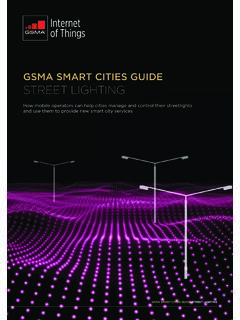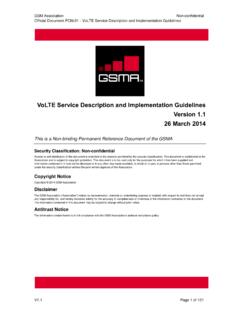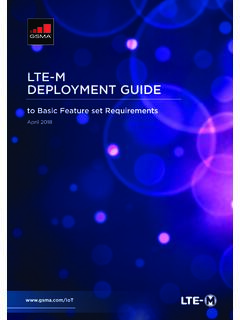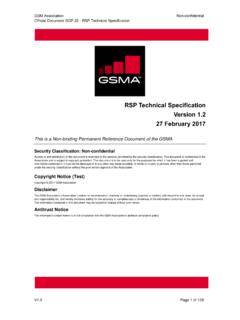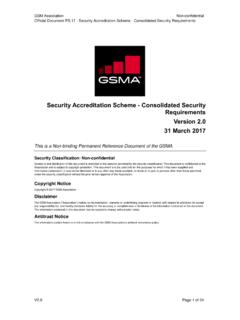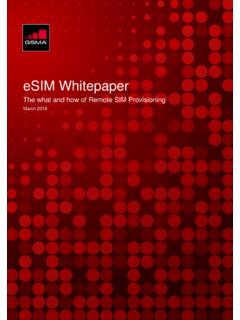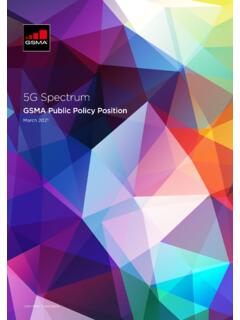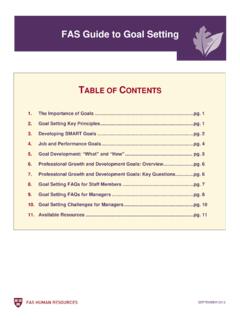Transcription of GSMA SMArt CitieS Guide: WAter MAnAGeMent
1 GSMA SMArt CitieS guide : WAter MAnAGeMentWhy mobile operators are key partners for CitieS seeking to deploy sustainable WAter MAnAGeMent solutions INTRODUCTIONOver the next three decades, urban populations will continue to grow, as will incomes and WAter usage per capita, against a backdrop of a changing climate. By 2050, the UN forecasts that more than six billion people will be living in CitieS and global WAter demand will be about 55 per cent higher than today1. These factors could disrupt two of the essential services that are required for CitieS to flourish: the availability of affordable, safe, clean WAter and sewerage are increasingly looking to work with mobile operators and other stakeholders to address these challenges. Mobile operators SMArt WAter MAnAGeMent solutions employ Internet of Things (IoT) technologies to continuously monitor the environment, WAter resources and infrastructure, helping to ensure citizens have reliable and affordable safe, clean drinking WAter and sewerage services 24 hours a day, seven days a SMArt CitieS guide : WAter SMArt CitieS guide : WAter Management1 Source: UN World WAter Development Report 2014 Mobile operators are natural and effective key partners for CitieS and other stakeholders; the SMArt WAter MAnAGeMent solutions they provide are underpinned by efficient, reliable and secure communications delivered using licensed spectrum.
2 Mobile operators already provide a wide range of communication services over an extensive geographic area, encompassing the city WAter catchments and the remote WAter assets within operators SMArt WAter MAnAGeMent solutions have evolved rapidly in recent years, enabled by advances in mobile communication technologies and the growing availability of high performance, relatively low-cost IoT sensors. Operators can intelligently combine and quickly analyse data from remote IoT devices monitoring the environment, WAter resources and infrastructure with other data sources. That enables them to provide CitieS and utilities with visibility, control and situational awareness in near real operators also have a range of enterprise capabilities that can be used to support SMArt WAter solutions, enabling them to provide additional services across the WAter cycle value chain, including those illustrated in Figure 1.
3 Further details of mobile operator capabilities are provided later in this for SMArt WAter MAnAGeMent technologyGSMA SMArt CitieS guide : WAter SMArt CitieS guide : WAter ManagementFigure1 Mobile Operator SMArt WAter MAnAGeMent Service Offeringsiot d eviCeSm Sensorsm SMArt Metersm Camerasm Controllersm Actuators m AlarmsCoMMuniCAtionServiCeSm 2G/3Gm LT Em M2Mm Mobile IoTm VPN iotServiCeSm Platform Hostingm Device Discoverym Data Acquisition m Device Managementm Remote SIM Provisioning bi G dAtA & AnAlytiCSm Data Storagem Situational Awarenessm Predictive InsightsenterpriSe AppliCAtionSm Leakage Detectionm Network Optimisationm Asset Condition Monitoringm Environmental Monitoringm WAter Quality End to End Privacy and SecuritySmart WAter MAnAGeMent solutions from mobile operators can help deliver specific benefits, such as: \Improving WAter conservation; \Optimising the repair and replacement of ageing infrastructure; \Improving the response to climate change and extreme weather events; \Improving public health, WAter quality and environmental SMArt CitieS guide : WAter ManagementGSMA SMArt CitieS guide : WAter Management2 The 2014 Review of SMArt Metering and Intelligent WAter Networks in Australia & New ZealandImprovIng WAter ConservatIonGiven the growing threat of WAter shortages, governments, regional legislators and city leaders are establishing and promoting citizen engagement and participation in WAter conservation programmes.
4 These programmes often include several aspects each addressing different opportunities and motivations for WAter conservation, including: \Public education and citizen engagement \Financial incentives and penalty surcharges \Targeted WAter conservation initiatives, such as Domestic WAter conservation and usage reduction Landscape/outdoor WAter conservation and usage reduction Institutional, commercial, and industrial WAter conservation and usage reduction A high priority is to reduce leakage or Non-Revenue WAter (NRW) as it is known in the WAter industry. NRW is safe, clean WAter that is lost from within the WAter supply network before it reaches a paying customer. Losses can be real leakage losses from fractured pipes or apparent losses (for example, through theft, metering inaccuracies, or internal use by the WAter service provider). The need to conserve WAter and to reduce NRW are often the drivers behind the city-wide deployment of mobile-enabled SMArt WAter WAter meters provided by mobile operators reduce NRW typically by communicating details of WAter consumption daily to the city WAter service provider.
5 Some SMArt WAter meters also have the ability to detect and report leaks. Other IoT sensors can monitor pressure, flow volume and direction, delivering considerable information and insight into the conditions within the WAter supply information provided by SMArt WAter meters can also empower citizens. A householder could have a SMArt WAter application running on their SMArt phone to monitor their pipework for leakage and to manage their use of wate mobile enabled SMArt WAter meters, together with a range of other IoT sensors and SMArt WAter MAnAGeMent software applications, typically delivers the following WAter conservation benefits: \Demand reductions: typically a sustained reduction of more than 10% in residential WAter demand; \Improved leak detection, reducing non-revenue WAter ; \Optimised pressure MAnAGeMent , reducing energy consumption and leakage; \CAPEX savings from deferring augmentation of networks; \Improved billing accuracy; o Resulting from replacing aged and inaccurate meters; o Resulting from more customers being metered.
6 \Significant customer satisfaction and customer service benefits are likely to emerge in the future, stimulated by advances in metering and communications technologies and the deployment of the latest generation of SMArt meters supporting near real time communications via mobile the landscape irrigation systems used by homes, commercial properties, municipal parks and school properties, the WAter flow control is generally provided by timers linked to automated valves. In some cases, the irrigation systems are managed by property MAnAGeMent groups that have operations spanning multiple sites in different locations. Some groups manage hundreds or thousands of individual SMArt CitieS guide : WAter ManagementGSMA SMArt CitieS guide : WAter Managementcase stUDy conserVIng WAter By reDUcIng Waste 3 typical landscape irrigation system delivers approximately the same amount of WAter each day with little regard to the prevailing (or forecast) weather or how much WAter is actually needed by the landscape.
7 Often too much WAter is used, effectively wasting a precious resource and money. In some localities, 40 to 60 per cent of all urban WAter consumption is used for outdoor irrigation, and of that, at least 30 per cent may be WAter MAnAGeMent solutions from mobile operators can transform the MAnAGeMent of irrigation systems, helping cites and citizens to conserve WAter . For example, HydroPoint4 and AT&T have developed a SMArt irrigation manage-ment solution, called WeatherTRAK, designed to address this market. The WeatherTRAK solution uses a cloud-based high performance big data computing platform to calculate a local evapotranspiration value for almost any location. The key indicator of WAter need, evapotranspiration is calculated using wind, humidity, solar radiation and temperature as part of the input (ET)EVAPORATIONis a proven scientific process used to determine the optimum time to irrigate by calculating the loss of moisture in the soil through evaporation and plant transpiration \ SMArt CitieS guide : WAter ManagementGSMA SMArt CitieS guide : WAter ManagementWeatherTRAK uses an IoT solution to connect irrigation control points to its cloud platform, which analyses climate data and determines the appropriate watering required to sustain optimum plant health.
8 Although each irrigation controller does the calculations locally, it also delivers data in near real time to the big data analysis system where it is verified, validated and stored in the cloud. AT&T provides the wireless communications, a secure, dedicated virtual private network and a self-service MAnAGeMent platform that supports all of HydroPoint s data transport requirements. The AT&T wireless network is one of the most important links in the whole process, HydroPoint cofounder Chris Spain remarked. It s communicating real-time in two directions, so we have a mirror on the database up in the cloud as well as what s on the ground. In 2015, the HydroPoint solution saved its customers more than 15 billion gallons (over 56 million cubic meters) of WAter and $137 million in expenses. Examples of customer savings include5: \Salem City, Utah, saved one million gallons of WAter in 180 days.
9 Salem is demonstrating that sustainable WAter use is not only achievable, but that it Is also attractive from financial and operational perspectives. We re excited about our WAter savings, and we know Salem s citizens will enjoy the healthy landscapes and cost savings that HydroPoint delivers. Bruce Ward, Salem City Engineer \Adobe Creek Homeowners Association, Petaluma, California, saved over nine million gallons of WAter . We have saved up to 30% of our WAter usage year after year. Joan Murphy National Director of Sustainability, Adobe Creek Committee Chair. \The Monterey Peninsula Unified School District (MPUSD), California, has achieved a 42 per cent reduction of WAter use district wide, while one school reduced WAter use by 57 per cent. WeatherTRAK is a strong WAter conservation tool. David Chandler, Energy Specialist, MPUSD. \Fort Carson, a US Army post in Colorado, is saving 50 million gallons of WAter annually and has received a prestigious award for energy and WAter MAnAGeMent .
10 \Two Lockheed Martin sites in California have saved an estimated 100 million gallons and more than $1 million in a is demonstrating that sustainable WAter use is not only achievable, but that it Is also attractive from financial and operational perspectives. Bruce Ward, Salem City EngineerGSMA SMArt CitieS guide : WAter SMArt CitieS guide : WAter ManagementageIng WAter InfrastruCtureCities generally have extensive networks of buried WAter and sewerage pipelines of various sizes, which are expensive to replace. The WAter supply network is often formed of large diameter transmission pipework for bulk WAter supplies connected to smaller diameter distribution pipework supplying neighbourhoods or individual customers. In many CitieS , several of these assets were installed in the 1950s and 1960s and are now reaching the end of their useful service life: in some CitieS up to 40% of safe, clean treated WAter is lost due to leakage.
